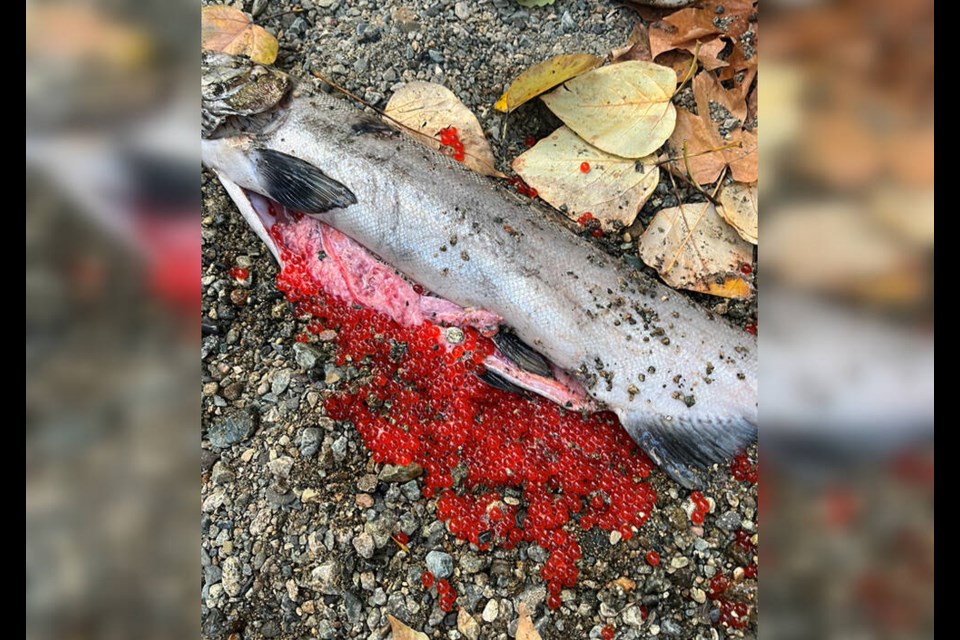Volunteers with the West Vancouver Streamkeeper Society are in shock after urban runoff killed dozens of coho salmon attempting to spawn in local creeks.
For years, the stewardship group has worked with West Vancouver Secondary students every fall to survey salmon returns in Brothers Creek. The first week of the survey found some promising numbers, but then at the end of October, it turned tragic, said John Barker, past president and volunteer with the Streamkeepers.
The creek banks below Inglewood Avenue were lined with more than 40 carcasses of otherwise healthy looking coho, which is extremely high for this early in the spawning season.
Barker walked the creek banks examining the carcasses. Three of the females he inspected still had full egg sacks, indicating they hadn’t yet spawned.
“So, this is just devastating,” he said. “In 20 years with the Streamkeepers, I’ve never seen an event like this.”
What killed the fish?
Barker said the society's contacts within Fisheries and Oceans Canada told them it was likely a case of urban runoff mortality syndrome, and the culprit was probably 6PPD-quinone – a chemical sprayed onto vehicle tires to prevent them from cracking.
The chemical builds up on roadsides where it becomes more toxic as it is exposed to sunlight. When it rains, the 6PPD is washed into the storm water system and, eventually, fish-bearing creeks.
Coho that are exposed to the chemical first show signs of being disoriented, losing their balance and swimming in circles.
“And there’s no recovery from it,” Barker said. “It looks like it’s a fairly sudden death.”
Bafflingly, the toxin affects different salmon species in different ways. Coho salmon are the most likely to be killed. Chum and pink salmon don’t seem to be affected at all, Barker said.
But why now?
6PPD isn’t a new chemical and its risks to coho have been well document since the 1990s, Barker said. What has changed though is our climate.
It used to be that late-summer or early-fall rains would flush the chemicals out of the creek system before the salmon returned. Now, with drought conditions lasting right into October, the toxic 6PPD and the coho are arriving in the creeks at the same time, Barker said.
“Everything is dry as can be and then we get one of these massive storms that comes in and just overloads us with water,” Barker said. “The loss is tragic and frightening to think of the future.”
Barker said it appears many of the dead fish had their adipose fins clipped, indicating they were likely ones that came from the Capilano River Hatchery. No one knows if wild-spawned salmon are less susceptible than their hatchery-bred cousins, although they do tend to be heartier overall.
While it’s too late for the dozens of fish killed by the runoff, Barker said there is some good news in that it appears to be an isolated incident.
The students were back out on the creek on Sunday and found more fish arriving in greater numbers and preparing to spawn, apparently unaffected by the late-October plume of 6PPD.
“This thing has done its damage and been washed away. It’s gone and it’s over. Anything arriving after that pulse is going to survive,” he said. “We’ve got coho coming through and good numbers and pink and chum salmon and fairly good numbers.”
Barker said their minds are now turning to how a similar tragedy might be prevented in the future.
While there is no movement afoot to see 6PPD pulled from the tire manufacturing process, there may be ways to mitigate the pollution before it hits the waterways. Barker said there has been some proven success in using plant- and soil-based filtration systems at major entrances to the storm water system to capture the offending chemicals before they harm wildlife.
This is something they plan to bring up with the District of West Vancouver, Barker said, although he said it would be a huge project to tackle.
“I can’t imagine the magnitude of what it would take to slow down what happened, but I’ve read that has been some success,” he said “It sounds like a fairly hefty undertaking but at the expense of fish, this is well worth exploring.”
No one from Fisheries and Oceans Canada responded to a North Shore News request for comment on Tuesday.




